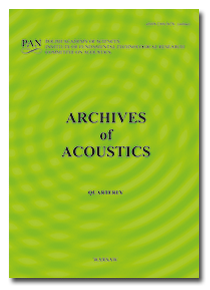Archives of Acoustics,
4, 1, pp. 73-86, 1979
Complexity investigation in solutions of ZnCl2 and LiCI in water using an acoustic method
The formation of complex ions brings about in water solutions a destruction of the water structure, thus leading to the formation of a new structure in the solution which is considerably less cohesive than the original water structure.
The investigations performed with zinc chloride and lithium chloride solutions in water indicate that those solutions in which the ratio of zinc atoms to chlorine atoms is near to 1:4, i.e. near to the ratio for the formation of ZnCI^{–2}_{4}, have maximum adiabatic compressibility, minimum hydration number and minimum viscosity. Measurements of the absorption coefficient of ultrasonic waves have shown that the process of relaxation of the formation and disintegration of complex ions with a relaxation time of 10^{-8} s exerts a predominating influence on the sound absorption.
The investigations performed with zinc chloride and lithium chloride solutions in water indicate that those solutions in which the ratio of zinc atoms to chlorine atoms is near to 1:4, i.e. near to the ratio for the formation of ZnCI^{–2}_{4}, have maximum adiabatic compressibility, minimum hydration number and minimum viscosity. Measurements of the absorption coefficient of ultrasonic waves have shown that the process of relaxation of the formation and disintegration of complex ions with a relaxation time of 10^{-8} s exerts a predominating influence on the sound absorption.
Full Text:
PDF
Copyright © Polish Academy of Sciences & Institute of Fundamental Technological Research (IPPT PAN).
References
E. JÓZEFOWICZ, Inorganic chemistry [in Polish] PWN, Warszawa 1959, 137-153.
H. R. OSWALD, H. JAGGI, Helv. Chim. Acta 43, 72 (1960).
R. A. ROBINSON, R. H. STOKES, Electrolyte solutions, Butterworths Sciences Public, London 1959.
A. C. HARRIS, H. N. PARTON, Trans. Faraday Soc., 36, 1139 (1940).





